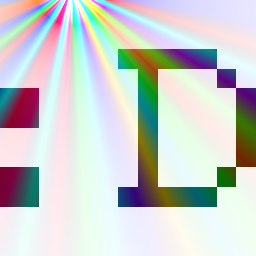note: this bot is no longer running. it had a decent following but for me it is an art project that ran its course. the code is from January 2021 and should still work (with minor modifications) if you want to make some funky desktop backgrounds or something
What
I run a mastodon bot at @sharpenart@botsin.space. It posts some crunchy lookin' art every hour. Following is an explanation of how it works.
Actually generating the images (sharpenart.sh)
#!/usr/bin/env bash
size=1000x1000 # this could be any ratio, of course, it's just the size I wanted it to generate
name=$(cat /proc/sys/kernel/random/uuid).png # random filename
# could change the values of the above variables to $1 and $2, so that the script could be invoked like "./sharpenart.sh 1280x720 mycoolart.png"
# this function generates an image that's just one random color. it generates hex triplets in a very silly way!
random_square () {
convert -size $size xc:white -fill "#$(for i in {1..6}; do hex=$hex$(shuf -n 1 -e 0 1 2 3 4 5 6 7 8 9 a b c d e f); done; echo $hex; hex=)" -opaque white $1
}
random_square color1.png; random_square color2.png # we need two randomly colored squares. (though I guess they wouldn't be squares if you set $size to something else)
convert -size $size xc: +noise Random random.png # here's where the randomness comes in -- an image that's just randomly colored pixels
convert color1.png color2.png random.png -composite $name # I actually don't fully understand what happens in this step but basically the two colored squares get smooshed together in a random way
blur_sigma=$(shuf -n 1 -e {5..50}); blur_radius=$(shuf -n 1 -e {5..50}) # more silly random number generation
convert -blur ${blur_radius}x${blur_sigma} $name $name # now the image gets blurred a random amount, to soften out the noise and create some orderly blobs
echo sharpening... # all those other steps execute pretty quickly, but the sharpening takes a bit so I want to know when it's doing it
for i in $(seq $(shuf -n 1 -e {5..20})); do cpulimit -l 10 -fq -- convert -sharpen 0x$(shuf -n 1 -e {1..20}) $name $name; echo did round $i; done # now it gets sharpened too much (but by a random amount), which is the effect that made me want to do this in the first place! (cpulimit prevents it from taking up server resources -- this is a very computationally heavy process.)
mv $name ~/sharpenart/ # it's important for the bot that there be a directory that only includes the output images
echo done.Run the generation script periodically (sharpenartcontroller.sh)
#!/usr/bin/env bash
while true; do
backlog=$(ls ~/sharpenart | wc -l) # so this is where the bot gets silly
if [ $backlog -lt 25 ]; then # it basically checks if 24 or fewer images (i.e. a day's worth) and if there is it generates 24 more (another day's worth)
for i in {1..24}; do # there doesn't really need to be that many images at one time but w/e
./sharpenart.sh;
done
else
echo backlog contains $backlog images
fi
echo checked at $(date)
sleep 1h
donePost those images! (sharpenposter.sh)
#!/usr/bin/env bash
while true; do
echo $(date) # because why not
file=$(ls | shuf -n 1) # this script is run in ~/sharpenart, to be clear
toot post -m $file # toot is set up beforehand to post to @sharpenart@botsin.space, of course
trash $file # doesn't need to be trash, could be rm. but w/e
sleep 1h # of course this bot doesn't post Every Hour On The Hour because "toot" takes a few seconds to run
doneUgh!
Don't you just love "$(seq $(shuf -n 1 -e {5..20}))"?
There are some silly design decisions here (starting with the choice of language), but hey, whatever, I'm not a Real Programmer and it basically works.
